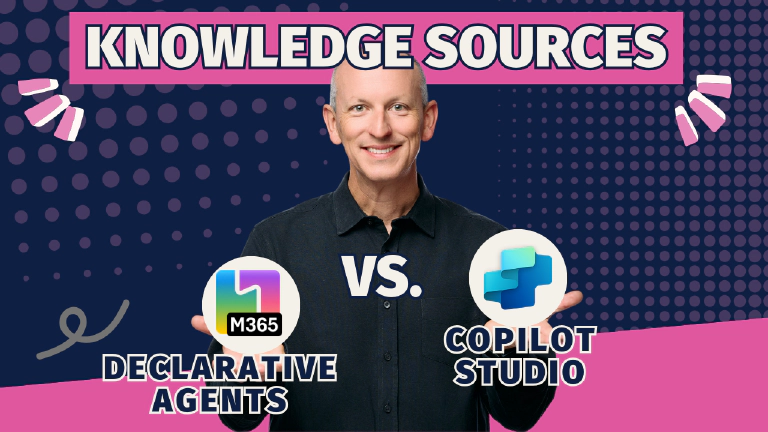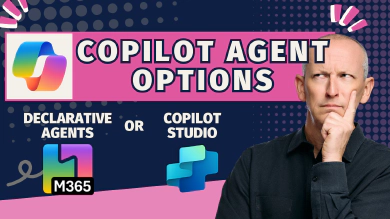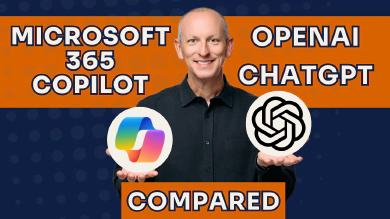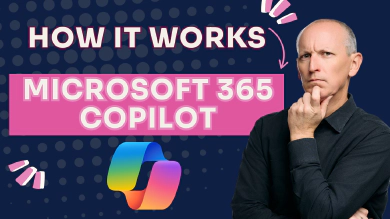A couple of weeks ago, I published an article about extending Microsoft 365 Copilot and how frustrated I was that Microsoft constantly overlooks the declarative agents option. Microsoft only promotes SharePoint agents, Copilot Studio Light (formerly agent builder), and Copilot Studio Pro, implying there’s no other option for custom agents.
The overlooked middle-ground solution for Microsoft 365 Copilot extensibility: declarative agents offer powerful capabilities beyond Copilot Studio without custom code.
https://www.voitanos.io/blog/microsoft-365-copilot-extensibility-options-declarative-agents-copilot-studio/
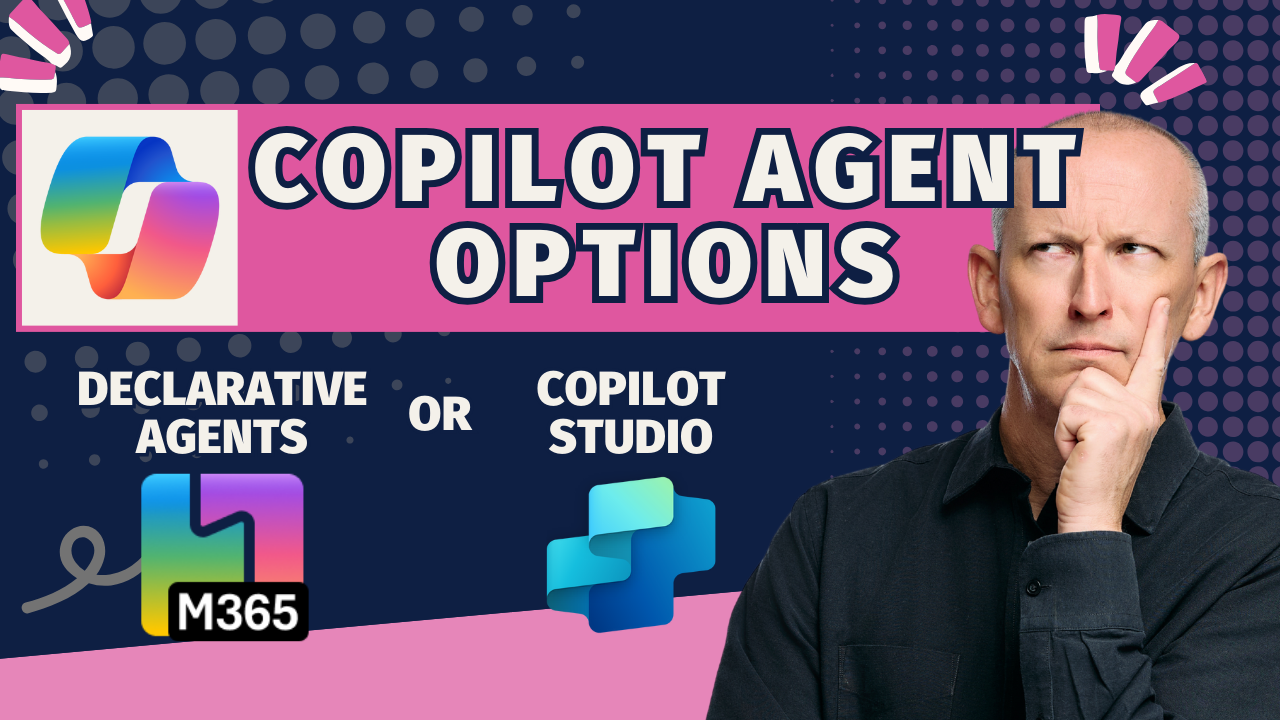
Since then, I’ve received many questions about the differences between declarative agents created with the Microsoft 365 Agents Toolkit (ATK) and agents created with Copilot Studio. Today, I want to focus specifically on knowledge sources and connectors - one of the more significant differences between these approaches.
At first glance, they seem very similar, but the devil is always in the details…
Understanding knowledge in AI agents
Before diving into the differences, let me explain how knowledge works in AI-based chatbots like Microsoft 365 Copilot.
All AI chatbots use foundational models (like GPT4o or, lately, GPT5) that have knowledge from their training data. But as I explained in my article comparing M365 Copilot & ChatGPT, what makes Microsoft 365 Copilot powerful is its ability to add contextual data specific to your organization and the user’s prompt through the Retrieval Augmented Generation (RAG) pattern.
Compare M365 Copilot and ChatGPT from a developer's perspective. Learn key differences in security, data handling, and customization options.
https://www.voitanos.io/blog/microsoft-365-copilot-vs-chatgpt-developer-comparison/

When you ask Copilot to “summarize my meetings for today,” it can’t rely on its foundational knowledge alone. Instead, it identifies what additional data sources it needs, retrieves relevant information, and combines that with your prompt to generate a comprehensive response.
Both Copilot Studio agents and declarative agents support additional knowledge sources, but they work very differently in terms of capabilities and control.
Copilot Studio knowledge sources
Copilot Studio allows you to add knowledge from sources that may or may not already exist in Microsoft 365. When you upload files for an agent to use as knowledge, including existing SharePoint and OneDrive content, Copilot Studio stores everything in Dataverse, where it gets indexed into its own vector database.
Third-party connector limitations
Most companies don’t have all their organizational data in Microsoft 365. Typically you find they use specialized systems for support tickets, sales and financial data, ERP, and CRMs. But, if you can get M365 Copilot visibility into those external systems, it can yield more useful, insightful, and actionable responses to your prompts.
Copilot Studio can connect to several third-party sources using Power Platform connectors, including:
- Salesforce
- ServiceNow
- Confluence
- Zendesk
However, these connections come with limitations that restrict how you can use your knowledge:
All-or-nothing indexing: When you connect to Salesforce, Copilot Studio indexes every article in the knowledge base you select. You can’t select specific articles, or content types - it’s everything or nothing. The same limitation applies to ServiceNow, Confluence, and Zendesk.
No query-time filtering: When your agent needs information from these sources, you can’t specify that you want only certain knowledge bases or specific articles from Salesforce. You can only tell it “get knowledge from Salesforce,” and it searches through everything that was indexed. Again, the same is true with ServiceNow, Confluence, and Zendesk.
This lack of granular control can lead to irrelevant results and makes it difficult to create focused, specialized agents.
Declarative agents knowledge sources
Declarative agents created with the M365 ATK for VS Code offer significantly more powerful and flexible knowledge source options.
Microsoft-provided connectors
The biggest advantage is access to Microsoft’s extensive connector gallery. In the Microsoft 365 Admin Center (MAC), under the Copilot section’s Connectors gallery, you’ll find nearly 90 different connectors that Microsoft provides.
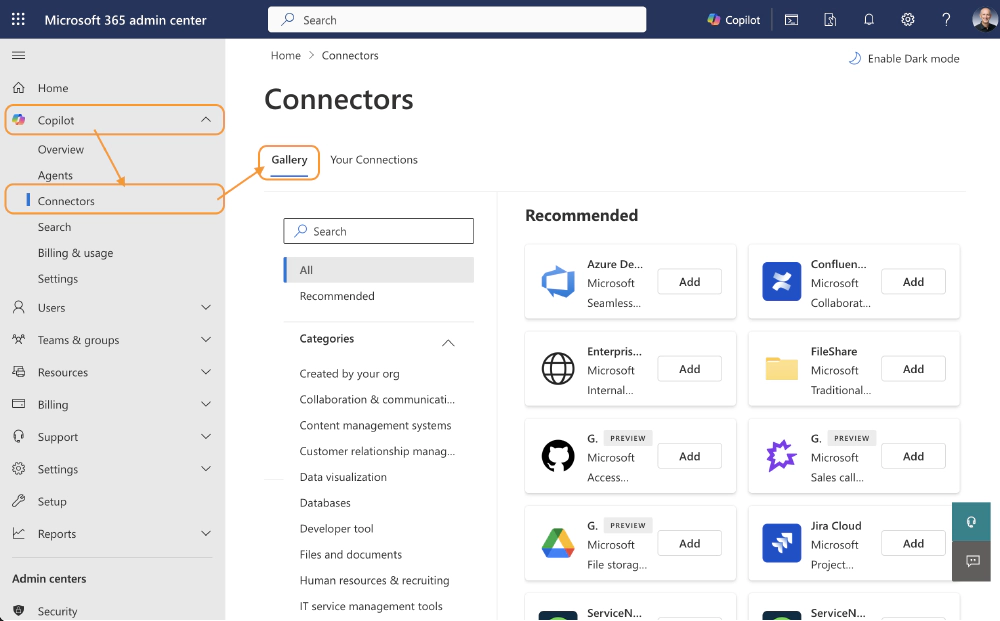
Microsoft 365 Copilot Connector Gallery in the Microsoft 365 Admin Center (MAC)
These include all the connectors available to Copilot Studio (OneDrive, SharePoint, Salesforce, ServiceNow, Confluence, Zendesk) plus many additional options:
- Amazon S3
- Asana
- Box
- Dropbox
- Google Drive
- Monday.com
- Oracle
- SAP
- SQL Server
- WordPress
- And many more
Advanced filtering capabilities: Unlike Copilot Studio, you can specify filters and criteria for the content that gets ingested. Microsoft crawls your selected content and creates vector embeddings based on your specifications, giving you much more control over what knowledge your agent can access.
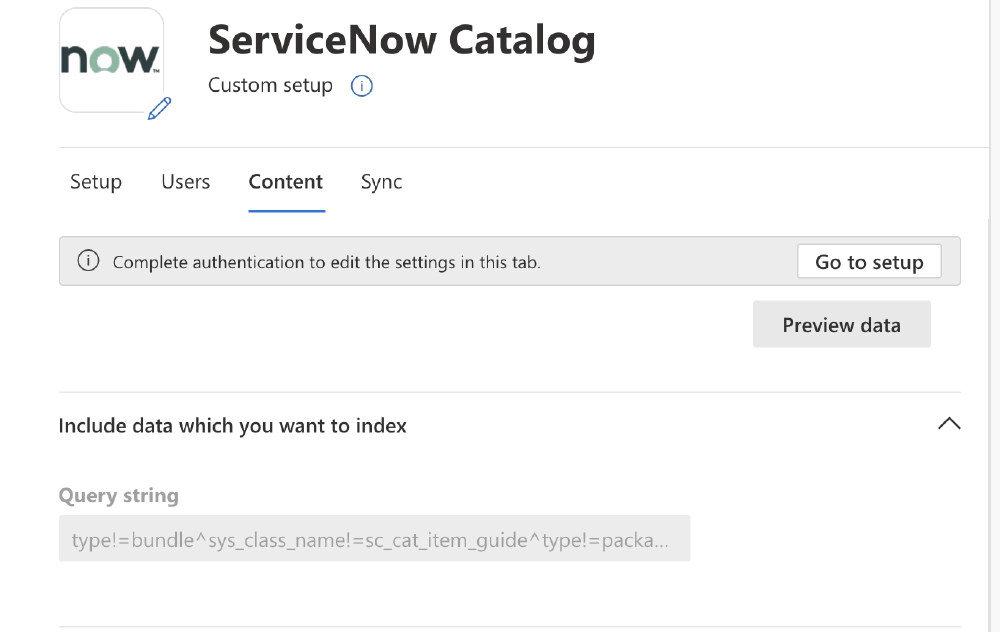
ServiceNow Copilot Connector - Notice the query string that can control what content is included and excluded as part of the ingestion process.
ServiceNow Copilot Connector - Notice the query string that can control what content is included and excluded as part of the ingestion process.
Semantic index integration
All content indexed through these connectors goes into Microsoft’s semantic index - the same system that powers Copilot’s RAG capabilities for Microsoft Graph data, SharePoint documents, OneDrive files, Teams messages, and meeting transcripts.
This integration provides several advantages:
- Cross-platform availability: Indexed content becomes available not just to your declarative agents, but also to Microsoft Search, Content IQ, and standard Copilot interactions… including Declarative agents created using the M365 ATK.
- Unified search experience: Users can discover this content through multiple Microsoft 365 entry points, creating a more cohesive knowledge ecosystem.
- Enhanced relevance: The semantic index uses Microsoft’s advanced AI to understand content relationships and context, improving search results and agent responses.
What’s the Semantic Index?
If you’re familiar with SharePoint search, you understand keyword indexing - documents get indexed, and when you search, you’re matching keywords to find relevant content.
The semantic index works differently.
Instead of keyword matching, it uses semantic relationships. If you search for “puppy,” it understands the relationship to “dog” is closer than to “cat,” and both are closer than to “automobile.”
Technically, the semantic index creates numerical representations (called embeddings) of text content and stores them in a vector database. When you submit a prompt, Copilot can perform semantic queries to find content that’s conceptually related to your request, not just keyword matches.
Microsoft creates this semantic index by indexing content from Microsoft Graph - your emails, documents, calendar items, and more. The security works just like SharePoint search: content in the semantic index maintains its original access control lists (ACLs), so Copilot will only see content that the current user has permission to access.
You can learn more about the semantic index from my article: How Microsoft 365 Copilot Works - The semantic index: Copilot’s knowledge foundation.
Custom connectors: The developer advantage
Here’s where declarative agents really shine for developers: custom copilot connectors (formerly called Graph connectors). These give you complete control over what content gets indexed and how it’s structured. Developers can create copilot connectors when there’s not a Microsoft-provided connector in the MAC’s Connector gallery.
Full content control
With custom connectors, you decide exactly what content to submit to Microsoft Graph for indexing. I’ve created custom connectors for various scenarios, including:
- Notion workspace integration: I built a custom connector that indexes specific content from my Notion workspace, allowing me to include only relevant pages and databases rather than everything.
- Course transcript indexing: I built another connector that in processes transcripts from my training courses, including metadata about lessons, chapters, and courses for better organization and searchability.
Semantic labeling
One of the most powerful features is semantic labeling, which lets you map your custom properties to properties that Microsoft 365 understands.
For example, I have course transcripts with a “full name” property that includes the lesson title, chapter title, and course title. By mapping this to Microsoft 365’s title semantic label property, when Copilot cites this content, users see the complete hierarchical context in the citation.
This level of semantic understanding helps both users and the AI agent better comprehend and reference your content.
Advanced security features
Custom connectors support sophisticated security through access control lists (ACLs):
- Granular permissions: You can secure each piece of content individually at the user level, group level, or even with external groups.
- Dynamic security: If a user doesn’t have access to specific content in the semantic index, it won’t appear in Copilot responses, ensuring your security policies are respected throughout the AI experience.
- Inheritance support: You can implement complex permission inheritance patterns that match your existing security models. These complex patterns are stored in your connector or the content you ingest, rather it’s defined in your Microsoft Entra ID configuration. Only the user or group is granted or denied access via the ACLs saved to the item when it’s ingested.
Enhanced user experience
Custom connectors also support advanced UX features:
- Adaptive cards: Define custom rendering for how your content appears when cited in Copilot responses. Users can see rich visualizations, detailed fact tables, or other contextual information when they hover over citations.
- User activity signals: Include data about user activities like views, comments, and updates. This signals to Copilot that certain content is more popular and relevant, improving the quality of responses.
- Rich metadata: Add extensive metadata to help both users and AI agents better understand and categorize your content.
Improved agent intelligence
When you create a declarative agent with the ATK, you can include property descriptions from your custom connector’s schema in your agent instructions. This helps your agent understand the semantic meaning of each property, leading to:
- Better content summarization
- More accurate responses to user queries
- Improved understanding of content relationships
- Enhanced ability to reference and cross-reference information
The knowledge architecture difference
The fundamental difference comes down to architecture. Copilot Studio creates its own isolated knowledge ecosystem within Dataverse, while declarative agents tap into Microsoft 365’s core knowledge infrastructure: the semantic index.
Copilot Studio approach: Your knowledge exists in a separate silo that only your Copilot Studio agent can access. This creates boundaries between your agent’s knowledge and the broader Microsoft 365 ecosystem.
Declarative agents approach: Your knowledge becomes part of the Microsoft 365 knowledge graph, making it available across the entire platform while maintaining security and access controls.
This architectural difference has profound implications for how users discover and interact with your content, how administrators add knowledge sources to those creating agents, and how your agents can provide contextually rich responses.
Choosing the right approach
The choice between Copilot Studio and declarative agents for knowledge sources depends on your specific needs:
Choose Copilot Studio if:
- You need a simple, low-code solution
- Your knowledge sources are straightforward (basic SharePoint/OneDrive content)
- You don’t need granular control over indexed content
- Your users primarily interact with the agent through dedicated channels
Choose declarative agents & copilot connectors if:
- You need extensive third-party connector options
- You want granular control over what content gets indexed
- You’re building custom connectors or have complex knowledge sources
- You want your knowledge integrated with the broader Microsoft 365 ecosystem
- You need advanced security, semantic labeling, or custom UX features
The knowledge and connector capabilities of declarative agents provide significantly more flexibility and power, especially for enterprise scenarios where control, security, and integration matter most.
What’s been your experience with knowledge sources in custom agents?
Have you run into the limitations I’ve described with Copilot Studio, or found creative ways to work around them?
Let me know in the comments below!

Microsoft MVP, Full-Stack Developer & Chief Course Artisan - Voitanos LLC.
Andrew Connell is a full stack developer who focuses on Microsoft Azure & Microsoft 365. He’s a 21-year recipient of Microsoft’s MVP award and has helped thousands of developers through the various courses he’s authored & taught. Whether it’s an introduction to the entire ecosystem, or a deep dive into a specific software, his resources, tools, and support help web developers become experts in the Microsoft 365 ecosystem, so they can become irreplaceable in their organization.
